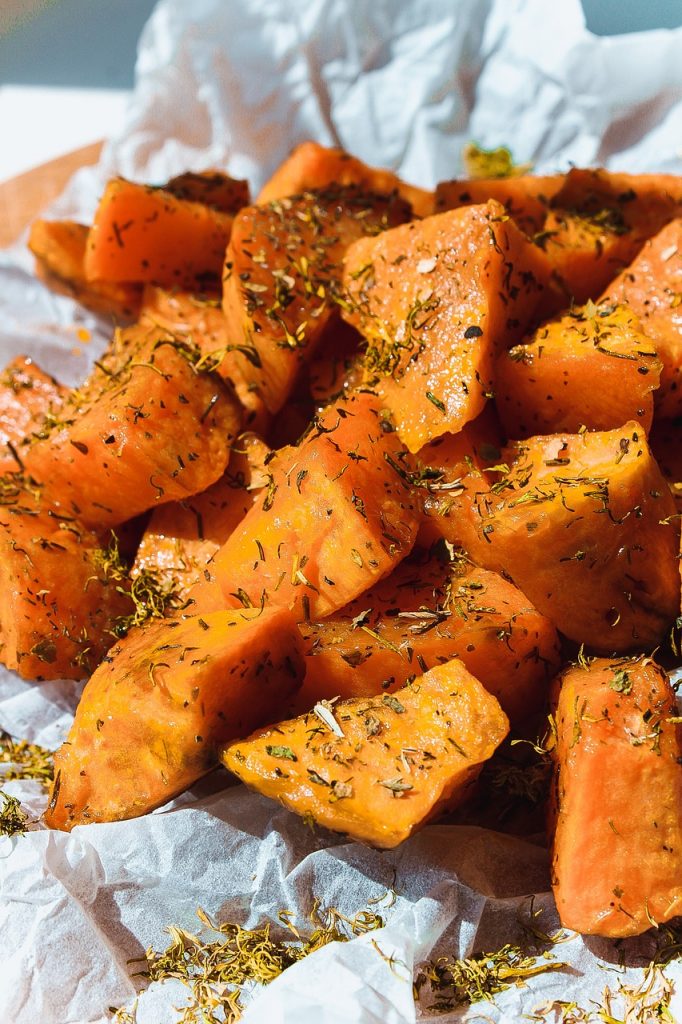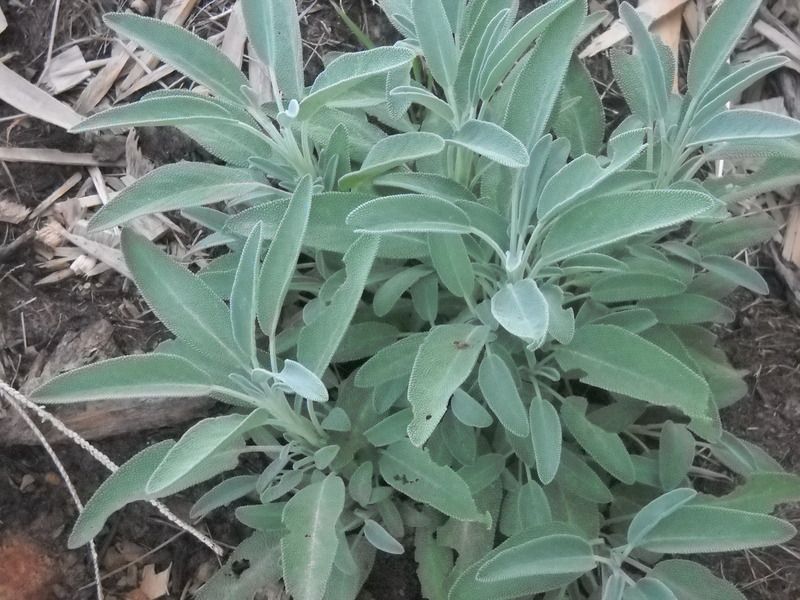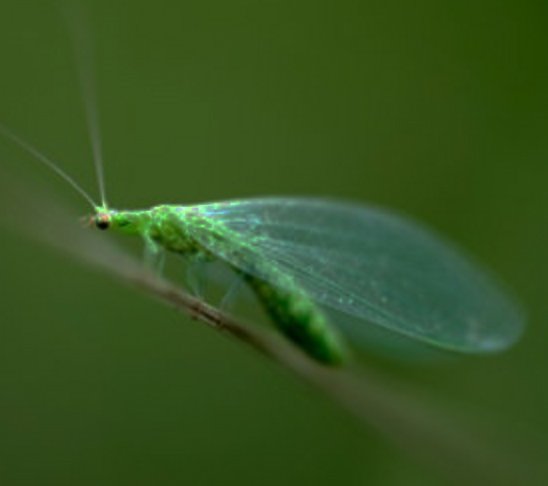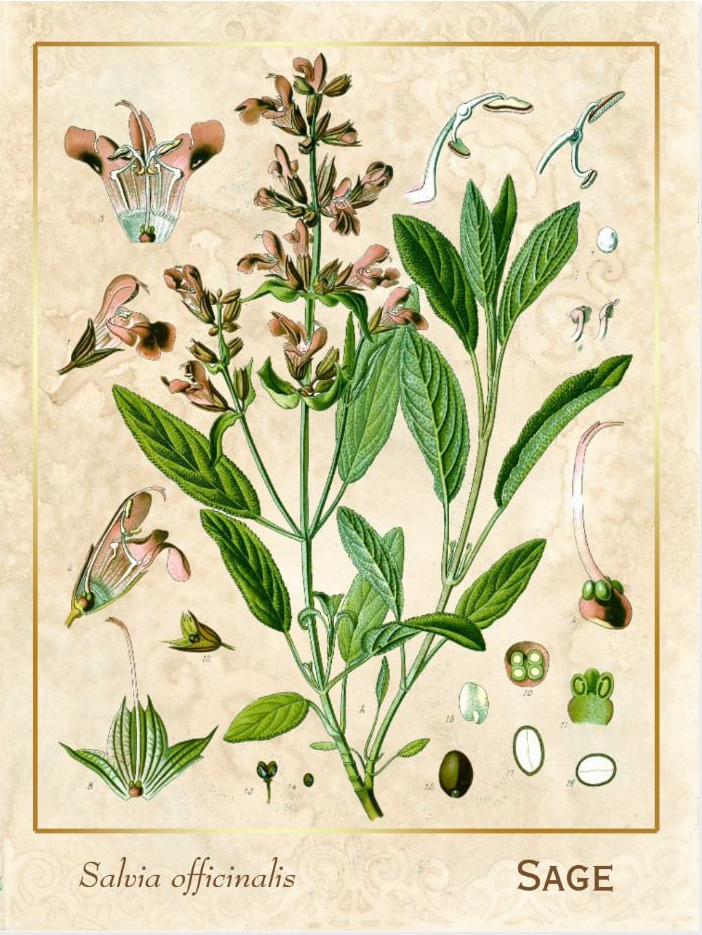Seasoning, beneficial companion plant, healing herb

Culinary Herb
Garden Sage, Salvia officinalis, is a versatile herb that we don’t tend to use as much as some of the other more common culinary herbs. It is indispensable, however, in a few seasonal dishes. I think some people only use sage once a year in their turkey stuffing at Thanksgiving. My Mom had an antique canister of rubbed sage in her pantry that she only used at Thanksgiving. Whether it still had any aroma or flavor was anyone’s guess. But, she used it each year just the same. (When using dried, powdered herbs, it’s a good idea to smell and taste them if they’ve been in the pantry a long time. The aroma and flavor should still be vibrant and alive. Dried herbs do lose their aroma and flavor after time. If yours has lost its oomph, replace it.)
It’s easy to overlook an herb that we are not familiar with. But, the creative cook will find ways to use sage all during the year. Sage pairs well with sweet potatoes, especially for those of us who think sweet potatoes are sweet enough on their own and bake them without added sugary ingredients. Just sprinkle some chopped, fresh sage over sweet potatoes when baking them or oven frying them on a sheet pan. Or add sage butter- see below- before you serve them.

Photo from Pixabay
Winter squash like acorn, butternut or Delicata also melds well with the flavor of sage. I like to put some butter and chopped fresh or dried sage leaves in the center of a half a winter squash and oven bake it until it’s tender. Delish! I also like to add it to mashed squash or sweet potatoes.
Sage Butter
Sage butter is easy to make and preserves the flavor of fresh sage. To make sage butter, or any herb butter, let the butter come to room temperature and place the butter with chopped fresh herbs of your choice in a bowl that allows enough room to stir and fold the herbs into the butter. Once you have incorporated the herbs, place your herbed butter in a container with a tight lid and refrigerate. For longer term storage, freeze the herb butter. A convenient way to freeze herb butter is in small amounts, made with a melon baller or small cookie scoop. Place the balls on a parchment lined cookie sheet and freeze overnight. In the morning place the herbed butter balls in a container or freezer bag. Now you have small amounts to use in cooking or for table use.
Add sage to soups, stews and sauces. Sage pairs well with white potatoes (potato soup), chicken and other poultry. The flavor of sage is strong, so a little can go a long way.
In the Garden

A well stocked herb garden should definitely include sage. It doesn’t run or bully other plants that we plant close to it. I’m looking at you, Oregano! If you live in a temperate climate, you can grow your sage in lots of sun with well draining soil. If you live in a hot, humid climate, like I do here in South Central Texas, grow it in more shade than sun. Good drainage is a must. I grow my sage in a container under a big oak tree. It only gets a small amount of sun and it has thrived there for years. I don’t move it in the winter and it has survived several very cold snaps in the winter.
It is very cold tolerant, surviving down to Zone 4. For best winter results in frigid climates, mulch it heavily and make sure it doesn’t sit in soggy soil. Good drainage is essential here.
Growing Sage
Sage is fairly easy to grow from seed. The seeds are large and easy to handle. It germinates in 7 to 10 days and then grows quickly. Follow the instructions on the seed packet for best results. Buying a starter plant is, of course, another way to go. You should be able to find small starter plants in the spring. If you like to grow plants from cuttings, sage is a good candidate for that, too. If you have a friend with a healthy plant, ask for a few cuttings and follow general procedures for sticking cuttings.
Beneficial Companion Plant
In the garden, sage will help attract beneficial insects and pollinators to your space. Along with many of our other beloved herbs such as rosemary, oregano and thyme, the flowers of the sage plant attract green lacewings and parasitic wasps- insects that devour pests that can bother vegetable plants like radishes, lettuce and kale. Sage keeps the aphid population low on lettuce plants.

Green Lacewing
It’s always good to remember, plants under stress attract pests more than healthy plants. So, if you see a lot of insect damage on your vegetable plants, look for the reasons the plant isn’t thriving. Is it in too much sun? Does it need nutrition? Does it need more frequent watering? There are reasons our plants show stress and many times the fix is simple. We just need to be vigilant and see that we meet our plants’ needs.
Healing Herb
As with many of our popular culinary herbs, sage offers health benefits along with its flavoring for our food. The botanical name for sage, Salvia, comes from the Latin “to heal” or “to save”. Herbalists of the various schools of herbalism use sage to soothe a sore throat, aid digestion, “move blood” and to relieve pain. Sage works to reduce inflammation in the digestive tract and therefore aid digestion. A cup of sage tea with some honey can relieve the bloated feeling that can come after eating. Sage tea is especially good at soothing the stomach after eating fatty foods.
We’re learning more about sage as an herb to help with focus and mental clarity. Aromatherapists recommend keeping a pot of sage or some fresh sage leaves near your workspace. When you feel your concentration wandering, crush or rub a sage leaf and inhale the aroma to bring back your focus. If you prefer the scent of Rosemary, use it in the same manner.
Here is more on the health benefits of sage from Rosalee de la Foret, an herbalist I follow and take classes from.

In Conclusion
I hope this closer look at Sage, Salvia officinalis, will encourage you to grow some sage in your herb garden and use it more in the kitchen and for wellness.
Read on
If you’re looking for more reading on herbs, try some of these
